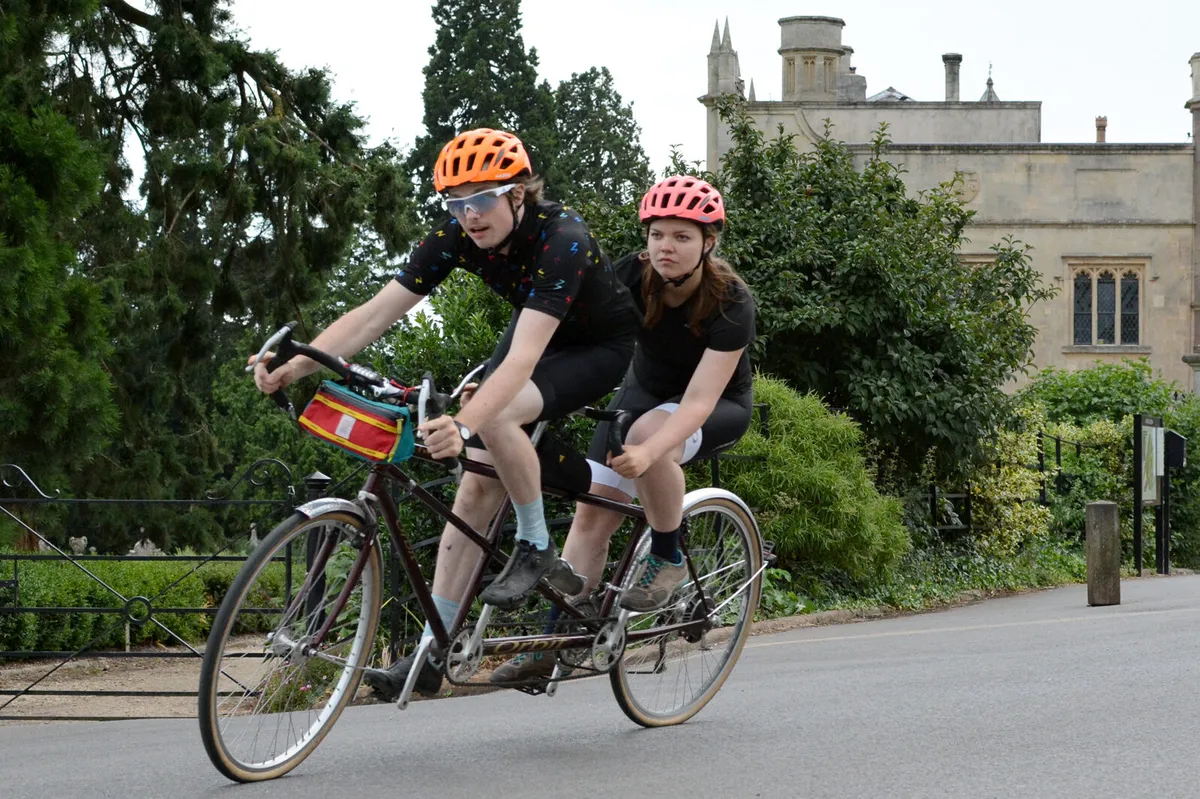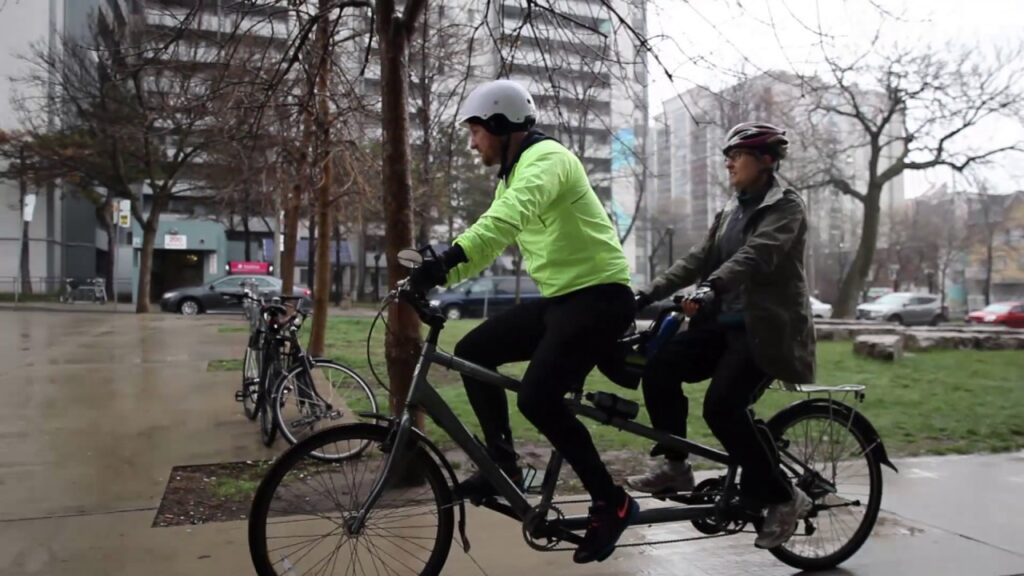To ride a tandem bike, coordinate with your partner and communicate for balance and harmony. Find your seating position, focus on pedaling together, and communicate effectively for a smooth ride.
Riding a tandem bike can be a fun and rewarding experience for couples, friends, or family members. It requires coordination, communication, and mutual trust to achieve a smooth, enjoyable ride. Whether you are a novice or an experienced cyclist, tandem biking offers a unique way to explore new places and strengthen relationships.
We will explore the essential steps and tips for riding a tandem bike safely and effectively. From choosing the right partner to mastering the art of synchronization, you will learn everything you need to know to make the most of your tandem biking adventure. So, strap on your helmet, hop on, and let’s ride into the world of tandem biking!

Credit: www.roadid.com
Choosing The Right Tandem Bike
Riding a tandem bike can be a fun and rewarding experience, but before you hit the road with your partner, it’s important to choose the right tandem bike that suits your needs and preferences. In this section, we will discuss the key considerations for size and the different styles available. By understanding these factors, you can make an informed decision and have an enjoyable tandem riding experience.
Considerations For Size
When selecting a tandem bike, size is crucial to ensure comfort and proper performance. Take into account the following factors:
- Frame size: Choose a frame size that accommodates both riders comfortably. It’s essential to have ample legroom and the ability to reach the handlebars comfortably. A bike shop expert can help you determine the appropriate frame size based on your measurements.
- Adjustability: Look for a tandem bike that offers adjustable seats and handlebars. This feature allows you to customize the bike to fit your individual and partner’s preferences.
- Weight limit: Consider the maximum weight limit of the tandem bike. It’s essential to ensure that the bike can safely support both riders. Verify this information with the manufacturer or bike shop.
- Step-through frame: If one of the riders has difficulty getting on and off a standard frame, consider a tandem bike with a step-through frame. This design makes mounting and dismounting easier.
Understanding Different Styles
Tandem bikes come in various styles, each with its own characteristics and purposes. Understanding these styles will help you choose the one that fits your riding style and preferences:
| Style | Description |
|---|---|
| Road Tandem | A popular choice for cyclists who enjoy speed and long-distance rides. These bikes are lightweight and designed for efficient road riding. |
| Mountain Tandem | If you prefer off-road adventures and trail riding, a mountain tandem bike is the best option. These bikes usually have sturdy frames, wide tires, and suspension for better off-road performance. |
| City Tandem | Perfect for urban rides and commuting, city tandems offer comfort, stability, and practical features like fenders, racks, and lights. |
| Recumbent Tandem | A recumbent tandem bike allows riders to sit in a reclined position, offering enhanced comfort and aerodynamics. These bikes are ideal for longer rides and touring. |
By considering size and understanding different styles, you can choose the perfect tandem bike that suits your needs. Whether you prefer road cycling, mountain biking, or city commuting, there’s a tandem bike out there waiting for you. Happy riding!
Basic Tandem Bike Features
When riding a tandem bike, understanding the basic features is essential. These features, such as the frame design, braking system, and gearing, play a crucial role in controlling the bike and ensuring a smooth ride. Let’s delve into the basic tandem bike features to gain a better understanding of how to ride this unique bicycle.
Frame Design
The frame design of a tandem bike differs from that of a traditional bicycle. Tandem bikes are equipped with an elongated frame that accommodates two riders in a front and rear position. This design allows for better weight distribution and ensures stability, making it ideal for riding with a companion.
Braking System
The braking system on a tandem bike is a critical component for ensuring safety and control. Tandem bikes often come with dual brake systems, allowing both riders to engage the brakes when necessary. It’s essential for both riders to communicate and coordinate their braking actions to ensure a smooth and safe ride.
Gearing
Efficient gearing is essential for a tandem bike to navigate various terrains smoothly. Tandem bikes are equipped with a wide range of gears to accommodate the combined power of two riders. The gears should be selected based on the terrain and the combined strength and ability of both riders, allowing for efficient pedaling and a comfortable ride.
Pre-ride Safety Check
Inspecting The Frame
Before hitting the road on a tandem bike, always check the frame for any cracks or damage.
Checking The Brakes
Ensure the brakes are in proper working condition by squeezing the levers to see if they engage smoothly.
Adjusting The Gears
Before riding a tandem bike, confirm that the gears are properly adjusted for a seamless cycling experience.
Mounting And Dismounting The Bike
Mounting and dismounting a tandem bike is a crucial aspect of riding in sync with your partner. Proper coordination and technique are necessary to ensure a smooth start and stop. Here’s how to get on and off a tandem bike seamlessly:
Positioning The Bike
Before mounting the tandem bike, ensure it is on level ground and perpendicular to the direction of travel. The captain, seated in the front, should hold the handlebars firmly while the stoker, in the rear, holds the seat or the rear handlebar for stability.
Coordinating Movements
When both riders are ready, the captain should brace the bike by putting one foot on the ground while the stoker keeps both feet on the pedals at the starting position. Utilize a designated signal like a gentle tap or a verbal cue to coordinate movements to ensure a smooth start. As the captain begins pedaling, the stoker follows suit and the journey begins!
Establishing Communication
Establishing Communication is crucial when riding a tandem bike. This ensures a smooth and coordinated experience between the riders.
Using Hand Signals
Hand signals help indicate turns and stops to ensure synchronized movement while on a tandem bike. Clear gestures are essential for effective communication between riders.
Verbal Commands
Verbal commands such as “left turn,” “right turn,” and “braking” are fundamental for effective communication between tandem bike riders. Clear and concise instructions are key to a safe ride.
Balance And Coordination
Discover the fun of riding a tandem bike, where balance and coordination are key. By synchronizing movements, riders can enjoy a smooth and enjoyable journey together. Mastering these skills will lead to a seamless tandem biking experience for all involved.
Aligning Pedaling
To ensure a smooth tandem bike ride, it is crucial to align your pedaling with your partner. Coordination is key here. Together, you and your partner need to synchronize your movements so that you are both pedaling at the same pace. This will not only enhance your balance, but it will also prevent any jerky motion that could potentially wobble the bike. Remember, teamwork is essential when it comes to aligning your pedaling!
Keeping A Steady Pace
Maintaining a consistent and steady pace is another vital aspect of riding a tandem bike. This requires both balance and coordination between you and your partner. By keeping a steady rhythm, you minimize the risk of losing stability and experiencing any unnecessary jolts. Smooth pedaling, combined with effective communication, allows you both to anticipate any changes in speed or direction, ensuring a safe and enjoyable ride. Remember, practice makes perfect when it comes to maintaining a steady pace on a tandem bike! Now, you may be wondering how exactly you can improve your balance and coordination while riding a tandem bike. Here are some practical tips to help you master these essential skills:
Balance And Coordination Tips:
| Tips for Balance | Tips for Coordination |
|---|---|
| 1. Keep your eyes forward, focusing on the road or trail ahead. | 1. Communicate with your partner to establish a rhythm and anticipate any changes. |
| 2. Hold onto the handlebars firmly but not too tightly, allowing for controlled movement. | 2. Listen to your partner’s cues, such as when they need to slow down or speed up. |
| 3. Distribute your weight evenly between both pedals, avoiding leaning too heavily. | 3. Practice pedaling in sync, ensuring both riders are pushing and pulling at the same time. |
With these balance and coordination tips in mind, you’ll be on your way to a successful tandem bike ride. Remember, it’s all about finding your rhythm and working together as a team. So go ahead, hop on that tandem bike, and enjoy the ride with a partner by your side!
Navigating Turns And Curves
When it comes to riding a tandem bike, navigating turns and curves requires good communication and synchronization between both riders. Leaning and countersteering are essential techniques that help maintain stability and control. Additionally, communicating effectively with your stoker ensures a smooth and enjoyable ride. Let’s explore these aspects further.
Leaning And Countersteering
In order to navigate turns and curves effectively on a tandem bike, leaning and countersteering play a crucial role. When approaching a turn, both riders should shift their weight and lean into the curve. This helps in maintaining balance and preventing the bike from tipping over.
Moreover, countersteering is an important technique to initiate turns smoothly. As the captain (the rider in the front), you need to apply slight pressure to the handlebars in the opposite direction of the desired turn. This causes the bike to lean in the appropriate direction, making the turn feel more natural and controlled. Remember to communicate with your stoker to ensure you both lean and countersteer together.
Communicating With The Stoker
Communication between the captain and the stoker is of utmost importance when navigating turns and curves on a tandem bike. Clear and concise communication helps both riders anticipate and react to maneuvers smoothly.
One effective way to communicate is by using verbal cues. As the captain, you can use simple phrases such as “prepare to turn right” or “lean left.” This provides your stoker with information about upcoming turns and prompts them to adjust their positioning accordingly.
Another way to communicate is through physical cues. You can use hand signals to indicate your intentions. For example, extending your arm straight out to the right signifies a right turn, while bending your arm at the elbow and pointing upwards indicates a left turn.
Remember, the key to effective communication is to ensure your stoker understands your instructions and can react accordingly. This helps maintain synchronization and ensures a smoother ride through turns and curves.

Credit: www.earthridercycling.com
Synchronizing Riding Techniques
Riding a tandem bike requires a high level of synchronization between both riders to ensure a smooth and enjoyable experience. Each rider must match their cadence, maintain equal weight distribution, and communicate effectively. Let’s delve into the key techniques for synchronizing riding on a tandem bike.
Matching Cadence
Matching cadence is crucial for a harmonious ride on a tandem bike. Both riders should pedal at the same pace to maintain momentum and stability. Establishing a consistent rhythm will prevent jerky movements and ensure a seamless riding experience.
Maintaining Equal Weight Distribution
Equal weight distribution is essential for stability and control. Both riders should distribute their weight evenly to keep the bike balanced. This helps in maintaining stability while navigating corners and avoiding swaying motions.

Credit: www.bikeradar.com
Frequently Asked Questions For How To Ride A Tandem Bike
Is It Harder To Ride A Tandem Bike?
Riding a tandem bike can be a bit more challenging than riding a regular bike. The longer length and additional weight require coordination and communication between both riders. However, with practice and teamwork, it can be a fun and rewarding experience.
Do Both People Have To Pedal On A Tandem Bike?
Yes, both riders need to pedal on a tandem bike. It requires effort from both individuals to propel the bike forward.
What Are The Pedals In A Tandem Bike For 2 Riders?
The tandem bike for 2 riders has two sets of pedals for both riders to pedal together.
Who Is The Front Person On A Tandem Bike?
The front person on a tandem bike is called the pilot. They steer and control the bike’s movements.
Conclusion
Riding a tandem bike is a fun and rewarding experience that strengthens bonds and builds teamwork. Remember to communicate with your partner, pedal in sync, and enjoy the journey together. With practice and patience, you’ll master the art of tandem biking and create lasting memories with your riding companion.



